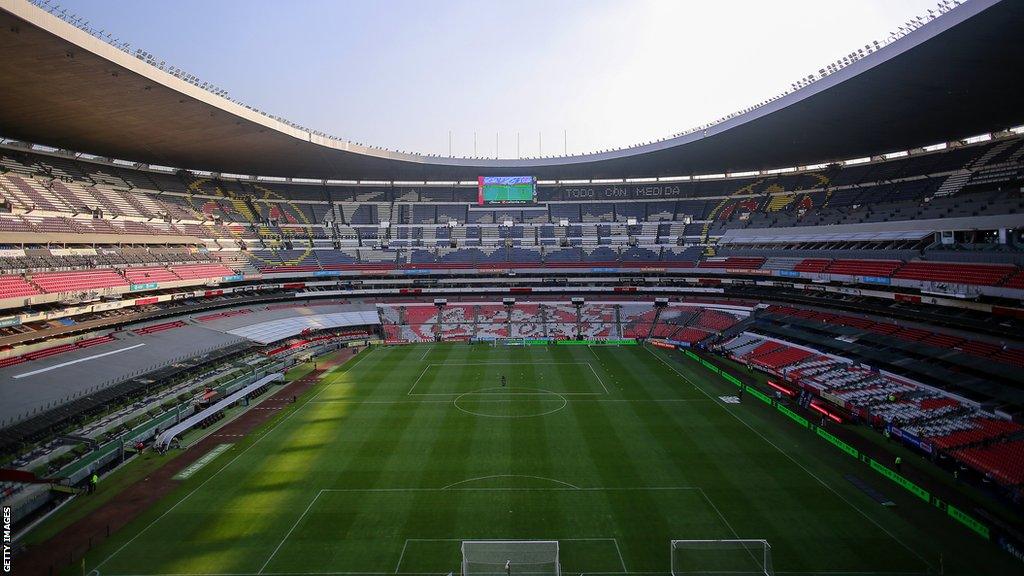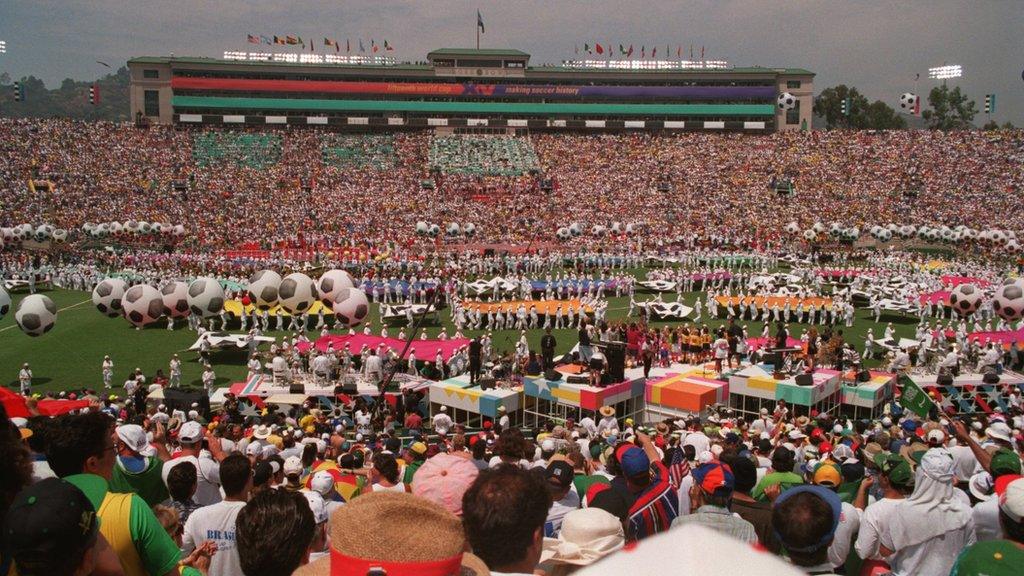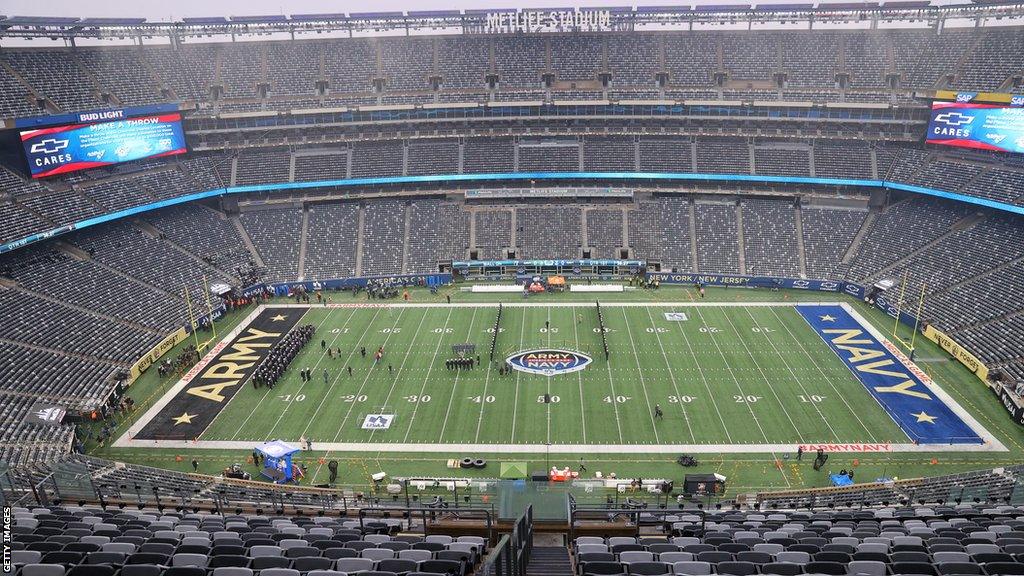What to expect from World Cup 2026: Number of teams, venues and format
- Published

The Estadio Azteca in Mexico City is the only stadium being used in 2026 that was used in the 1970 and 1986 World Cups
Qatar 2022 will go down as the most "compact" Fifa World Cup in history - but 2026 will be very different.
While all matches this time around were played within a hour's drive of each other, the next World Cup will be played across three nations - Canada, the United States and Mexico.
And it will be an expanded competition, with 16 additional teams taking part, meaning more matches.
However, the tournament will still be played out within five weeks from mid-June 2026.
Questions will be asked about the amount of travel players and fans will have to make, with the tournament being held in 11 US cities, along with three venues in Mexico and two in Canada.
Sustainability will, therefore, be an important issue with the considerable number of flights needed to transport teams, fans, media and Fifa officials across three countries.
Why will there be more teams than ever before in 2026?
Fifa is expanding the next men's World Cup finals from 32 to 48 teams.
It means more money will be generated through sponsorships, merchandising, ticket sales and broadcast revenues, with Fifa expecting to earn $11bn over the four-year cycle up to December 2026.
Bumper crowds are expected at the next World Cup as the popularity of football in North America continues to grow.
Fifa is projecting as many as 5.5 million fans will attend the next tournament, beating the record 3.6m supporters who attended games in 1994, when there was an average attendance of 68,000 at each game.
The governing body claims that much of the increased profit will be redistributed to football development around the world, with projects including investment to expand the women's game.
The expanded format will increase the number of competing teams from all of the world's football federations.
Oceania will be given one guaranteed spot at the finals and in 2026 there will be a minimum of 17 teams from across Africa and Asia.
A minimum of six Concacaf teams will qualify for the World Cup, including Canada, Mexico and the United States as hosts - and the federation will have two sides in the play-offs as well.
Where will the matches be played in 2026?

The World Cup final in 1994 was held at the Rose Bowl stadium in Pasadena, California
The 16 venues were announced in June, with all the grounds already built, and with the majority of big-capacity stadiums used by NFL teams in the United States.
Some of the stadiums will be upgraded before 2026 and some will require the laying of grass surfaces, as artificial turf is not permitted by Fifa.
As it stands, the format for 2026 will mean 80 matches across the tournament - although that could still change. The United States would host 60 matches, including every match from the quarter-finals onward, while neighbouring Canada and Mexico would each host 10 matches.
Both the US and Mexico have hosted the World Cup before - but most of the venues in 2026 will be different. The US is using none of the stadiums from 1994, while Mexico has just one venue from 1970 and 1986 - the iconic Estadio Azteca in Mexico City.
The host venues for 2026 are:
United States
New York/New Jersey (MetLife Stadium)
Los Angeles (SoFi Stadium)
Dallas (AT&T Stadium)
San Francisco Bay Area (Levi's Stadium)
Miami (Hard Rock Stadium)
Atlanta (Mercedes-Benz Stadium)
Seattle (Lumen Field)
Houston (NRG Stadium)
Philadelphia (Lincoln Financial Field)
Kansas City, Missouri (Arrowhead Stadium)
Boston/Foxborough (Gillette Stadium)
Canada
Toronto (BMO Field)
Vancouver (BC Place Stadium)
Mexico
Guadalajara (Estadio Akron)
Mexico City (Azteca Stadium)
Monterrey (BBVA Bancomer Stadium)
The geographical spread for the next World Cup has not yet been announced but it is likely that teams will play their group-stage games in regionalised zones.
There are three main venue clusters, which should help reduce the amount of travel needed at least for part of the tournament.
Western region:
Vancouver
Seattle
San Francisco Bay Area
Los Angeles
Guadalajara
Central Region:
Kansas City
Dallas
Atlanta
Houston
Monterrey
Mexico City
Eastern Region:
Toronto
Boston
Philadelphia
Miami
New York/New Jersey
How will the 2026 finals be structured?
A final decision will be made by the Fifa Council in 2023.
The initial favoured option was to have 16 groups of three teams. Each team would play two group games, rather than three, with the first two teams progressing to a new round of 32.
But the downside to that could be that the two teams playing in the last fixture could play out a specific result to send both teams through. That was alleged to have happened in 1982 when West Germany and Austria advanced at the expense of Algeria in the so-called 'Disgrace of Gijon'.
Given the success of the four-team group format in 2022, the structure for 2026 will be revisited, according to Fifa president Gianni Infantino.
"I have to say after this World Cup, and the success of the groups of four, we have to revisit or rediscuss the format whether we go for 16 groups of three or 12 groups of four."
The indications are that it will end up being 12 groups of four, effectively split into two halves (like two Euros in one go).
Another possibility, though one that appears unlikely, is that group games may not be allowed to finish as a draw. If the teams were level after 90 minutes, the outcome could be decided with a penalty shootout, without the need for extra time.
Where will the Fifa World Cup 2026 final be played?

The MetLife Stadium in New Jersey could host the final
That decision has not yet been made but it will be in the next year.
The front-runner to host the final is the MetLife Stadium in East Rutherford, New Jersey, which has a seated capacity of 82,500 and is home to the New York Giants and New York Jets NFL teams.
The Azteca in Mexico has been put forward as a potential host for the opening match.
Both venues are contenders to host the 2026 final, but Fifa president Infantino said world football's governing body will take their time with a decision.
"There are still some discussions to go on and we'll certainly choose the best cities for the openings and the finals," said Infantino.
"But every match will be like a final at this World Cup."
And what about 2030?
That will be a special centenary event, 100 years after the first Fifa World Cup in Uruguay, which was contested by just 13 teams.
Uruguay has claimed for some time that it should be awarded the tournament, possibly in a joint bid with Argentina.
Spain and Portugal hope to be put forward by Uefa, but England dropped its interest in favour of bidding for Uefa Euro 2028 along with Scotland, Wales, Northern Ireland and the Republic of Ireland.
Saudi Arabia could be another potential bidder, though that could mean another winter tournament because of the high summer temperatures in the Middle East.
A decision on the hosts of the 2030 tournament will be made by the Fifa Council in 2024.